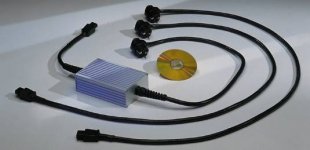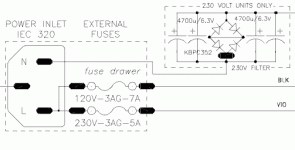Hello all,
Does anybody know more about the active mains cable made by the German manufacturer ASR?
The description sounds interesting, it's more than just a filter for mains "noise". They claim that there's also active components inside.
Does anybody have a clue as to what circuit could be inside?
Greetings,
Jarno.
Does anybody know more about the active mains cable made by the German manufacturer ASR?
The description sounds interesting, it's more than just a filter for mains "noise". They claim that there's also active components inside.
Does anybody have a clue as to what circuit could be inside?
Greetings,
Jarno.
Attachments
According to their site, it's a shielded cable, and the box contains
a DC-Filter and HF-suppresion.
http://www.asraudio.de/technik/asr_t_nk.html
Mike
a DC-Filter and HF-suppresion.
http://www.asraudio.de/technik/asr_t_nk.html
Mike
Hello Mike,
Yes, I've read all the articles on this cable so I know that there's a DC block and HF suppression in the box. The HF suppression could be a rather straightforward affair with some caps and inductance, oversized as well because it's rated at 2000VA. Now for the DC blocking stuff, how is this implemented? They say that there are active components inside, could they use these for the blocking of DC?
Does anybody have a possible schematic of this circuit?
Regards,
Jarno.
Yes, I've read all the articles on this cable so I know that there's a DC block and HF suppression in the box. The HF suppression could be a rather straightforward affair with some caps and inductance, oversized as well because it's rated at 2000VA. Now for the DC blocking stuff, how is this implemented? They say that there are active components inside, could they use these for the blocking of DC?
Does anybody have a possible schematic of this circuit?
Regards,
Jarno.
Are diodes or transils/trisils considered active components?
Most DC blocking circuits include these components to clamp the voltage drop across the blocking capacitor and prevent its destruction in case of overload
In the other hand, if 1 meter of shielded wire with two plastic-molded connectors, a 2KW EMI filter and a 2KW DC filter costs more than 30 euro then it's pure snake oil...
Also, this box is by far too small to have enough room for a decent 2KW EMI filter including common-mode filtering and differential-mode filtering, and a 2KW DC filter, so everything may be just a fairy tale
Most DC blocking circuits include these components to clamp the voltage drop across the blocking capacitor and prevent its destruction in case of overload
In the other hand, if 1 meter of shielded wire with two plastic-molded connectors, a 2KW EMI filter and a 2KW DC filter costs more than 30 euro then it's pure snake oil...
Also, this box is by far too small to have enough room for a decent 2KW EMI filter including common-mode filtering and differential-mode filtering, and a 2KW DC filter, so everything may be just a fairy tale
That's a very interesting article indeed. I don't believe in the audible superiority of expensive mains cables either, but I do believe that you can equip mains cables with extra functionality such as the suppression of mains borne nasties.
This is why I was wondering if somebody's got a clue as to what could be inside the box.
This is why I was wondering if somebody's got a clue as to what could be inside the box.
Konnichiwa,
Typhically the DC blocker circuit is a pair of Electrolytic Capacitors of large value (but fairly low voltage, ripple current must be high though) back to back with some form of protection diodes (most often found are simple bridge blocks with shorted +/- connections, AC connections across the capacitors.
BTW, in my view such DC protection is required for all torroidal transformers. The noise filter is also a good idea with these, as their superb HF coupling means any high frequency junk riding on the mains rides straight through the transformer.
So, ASR's "active" mainscable actually compensates for basic design flaws in the equipment, sadly design flaws that apply to 99.9% of all audio gear.
Sayonara
Jarno said:Now for the DC blocking stuff, how is this implemented? They say that there are active components inside, could they use these for the blocking of DC?
Typhically the DC blocker circuit is a pair of Electrolytic Capacitors of large value (but fairly low voltage, ripple current must be high though) back to back with some form of protection diodes (most often found are simple bridge blocks with shorted +/- connections, AC connections across the capacitors.
BTW, in my view such DC protection is required for all torroidal transformers. The noise filter is also a good idea with these, as their superb HF coupling means any high frequency junk riding on the mains rides straight through the transformer.
So, ASR's "active" mainscable actually compensates for basic design flaws in the equipment, sadly design flaws that apply to 99.9% of all audio gear.
Sayonara
I just fount that on a www.audiomap.de forum
A circuit like this seems to be build in in any Bryston amp...
Interestingly on the neutral side...
A circuit like this seems to be build in in any Bryston amp...
Interestingly on the neutral side...
Attachments
Konnichiwa,
Yes, that will work fine, the only thing that wouyld worry me slightly is that the circuit allows the Capacitors to be reversebiased by up to around 2V. No doubt the boffins at Bryston tested their specific capacitors to allow that kind operation, if you use generic stuff you would likely be better off connecting 2pcs 39,000uF...47,000uF in series, negative poles together. This the also allows to add more diodes allowing a higher DC voltage to be blocked.
As for inserting it in the neutral line, doesn't matter where the circuit is as long as it is in series with the primary of the mains transformer.
Sayonara
lohk said:I just fount that on a www.audiomap.de forum
A circuit like this seems to be build in in any Bryston amp...
Interestingly on the neutral side...
Yes, that will work fine, the only thing that wouyld worry me slightly is that the circuit allows the Capacitors to be reversebiased by up to around 2V. No doubt the boffins at Bryston tested their specific capacitors to allow that kind operation, if you use generic stuff you would likely be better off connecting 2pcs 39,000uF...47,000uF in series, negative poles together. This the also allows to add more diodes allowing a higher DC voltage to be blocked.
As for inserting it in the neutral line, doesn't matter where the circuit is as long as it is in series with the primary of the mains transformer.
Sayonara
I agree, and that is how I made my DC-blockers.
But - as I read somewhere - the electrolytic capacitors can stand a bit of reverse DC, behaving a bit like bipolars (we also often find polarized elcaps in the feedback path of amplifiers where there is certain AC voltage without DC biasing).
You are right, to get sure we should use two caps back2back.
But why should I bypass those caps with HQ foil caps as these guys from the mentioned forum suggest? I think it is better NOT to bypass them (it will maybe even help to block some HF noise too...)
Klaus
But - as I read somewhere - the electrolytic capacitors can stand a bit of reverse DC, behaving a bit like bipolars (we also often find polarized elcaps in the feedback path of amplifiers where there is certain AC voltage without DC biasing).
You are right, to get sure we should use two caps back2back.
But why should I bypass those caps with HQ foil caps as these guys from the mentioned forum suggest? I think it is better NOT to bypass them (it will maybe even help to block some HF noise too...)
Klaus
Konnichiwa,
Yes, Elcaps can stand a certain amount of reverse biasing and reverse current, but this is usually not a specified or guranteed parameter, so ideally we do not rely on that.
I do not do that, it might have to be tried, it will not cause any harm.... I see no reason why it should make things better, but you never know.
Sayonara
lohk said:But - as I read somewhere - the electrolytic capacitors can stand a bit of reverse DC, behaving a bit like bipolars (we also often find polarized elcaps in the feedback path of amplifiers where there is certain AC voltage without DC biasing).
Yes, Elcaps can stand a certain amount of reverse biasing and reverse current, but this is usually not a specified or guranteed parameter, so ideally we do not rely on that.
lohk said:But why should I bypass those caps with HQ foil caps as these guys from the mentioned forum suggest?
I do not do that, it might have to be tried, it will not cause any harm.... I see no reason why it should make things better, but you never know.
Sayonara
Hello all,
It's great to see interest in these subject. Regarding the claim of the manufacturer that there are "active components" inside that may get hot and that the enclosure itself acts as a heatsink for these components, for the blocking of DC you don't actually need those? Perhaps the diodes are indeed the active components?
I think I will give the "bryston" schematic a try.
Regards,
Jarno.
It's great to see interest in these subject. Regarding the claim of the manufacturer that there are "active components" inside that may get hot and that the enclosure itself acts as a heatsink for these components, for the blocking of DC you don't actually need those? Perhaps the diodes are indeed the active components?
I think I will give the "bryston" schematic a try.
Regards,
Jarno.
Konnichiwa,
Well, ignoring the manufacturers marketing claims for a moment, when significant current passes through our capacitors in our DC blocker they get warm to hot. The chokes use din the RF filter may also be subject to heating. So some cooling may very well be highly desirable.
Please make sure to test the capacitors before use with around 2V DC reverse voltage. There should be no observable current flow, if there is better avoid the Bryston appraoch and use the electrlytics back-to-back as most of these DC blockers do (eg Lamm, the ones I use, various ones described on the Net....
Sayonara
Jarno said:It's great to see interest in these subject. Regarding the claim of the manufacturer that there are "active components" inside that may get hot and that the enclosure itself acts as a heatsink for these components, for the blocking of DC you don't actually need those? Perhaps the diodes are indeed the active components?
Well, ignoring the manufacturers marketing claims for a moment, when significant current passes through our capacitors in our DC blocker they get warm to hot. The chokes use din the RF filter may also be subject to heating. So some cooling may very well be highly desirable.
Jarno said:I think I will give the "bryston" schematic a try.
Please make sure to test the capacitors before use with around 2V DC reverse voltage. There should be no observable current flow, if there is better avoid the Bryston appraoch and use the electrlytics back-to-back as most of these DC blockers do (eg Lamm, the ones I use, various ones described on the Net....
Sayonara
- Status
- This old topic is closed. If you want to reopen this topic, contact a moderator using the "Report Post" button.
- Home
- Amplifiers
- Solid State
- ASR Active mainscable

 Indeed.
Indeed.